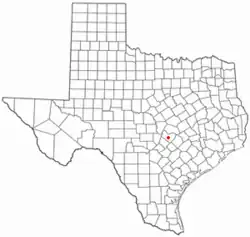Rollingwood, Texas | |
|---|---|
 Location of Rollingwood, Texas | |
| Coordinates: 30°16′29″N 97°47′4″W / 30.27472°N 97.78444°W | |
| Country | United States |
| State | Texas |
| County | Travis |
| Government | |
| • Type | City Council |
| • Mayor | Gavin Massingill[1] |
| Area | |
| • Total | 0.70 sq mi (1.81 km2) |
| • Land | 0.70 sq mi (1.81 km2) |
| • Water | 0.00 sq mi (0.00 km2) |
| Elevation | 646 ft (197 m) |
| Population (2020) | |
| • Total | 1,467 |
| • Density | 2,270.77/sq mi (876.82/km2) |
| Time zone | UTC-6 (Central (CST)) |
| • Summer (DST) | UTC-5 (CDT) |
| ZIP code | 78746 |
| Area code | 512 |
| FIPS code | 48-63008[3] |
| GNIS feature ID | 1345526[4] |
| Website | https://rollingwoodtx.gov/ |
Rollingwood is a city in Travis County, Texas, United States. Part of the Austin–Round Rock metropolitan area, the population was 1,467 at the 2020 census. While it is located in central Austin, it has a rural, wooded feel with rolling hills and a large park with play areas and four ball fields. Western Hills Athletic Club, a private swim and tennis club restricted to 400 households, is part of the park zone.
Geography
Rollingwood is located at 30°16′29″N 97°47′04″W / 30.274657°N 97.784501°W (30.274657, –97.784501),[5] three miles (5 km) west of downtown Austin.
According to the United States Census Bureau, the city has a total area of 0.7 square mile (1.8 km2), all land.
Demographics
| Census | Pop. | Note | %± |
|---|---|---|---|
| 1960 | 390 | — | |
| 1970 | 780 | 100.0% | |
| 1980 | 1,027 | 31.7% | |
| 1990 | 1,388 | 35.2% | |
| 2000 | 1,403 | 1.1% | |
| 2010 | 1,412 | 0.6% | |
| 2020 | 1,467 | 3.9% | |
| U.S. Decennial Census[6] | |||
| Race | Number | Percentage |
|---|---|---|
| White (NH) | 1,186 | 80.85% |
| Black or African American (NH) | 2 | 0.14% |
| Native American or Alaska Native (NH) | 3 | 0.2% |
| Asian (NH) | 68 | 4.64% |
| Mixed/Multi-Racial (NH) | 65 | 4.43% |
| Hispanic or Latino | 143 | 9.75% |
| Total | 1,467 |
As of the 2020 United States census, there were 1,467 people, 473 households, and 375 families residing in the city.
At the 2000 census there were 1,403 people in 489 households, including 413 families, in the city. The population density was 2,070.7 inhabitants per square mile (799.5/km2). There were 498 housing units at an average density of 735.0 per square mile (283.8/km2). The racial makeup of the city was 96.01% White, 0.21% Native American, 2.28% Asian, 0.50% from other races, and 1.00% from two or more races. Hispanic or Latino of any race were 4.92%.[3]
Of the 489 households 45.2% had children under the age of 18 living with them, 74.8% were married couples living together, 7.6% had a female householder with no husband present, and 15.5% were non-families. 12.9% of households were one person and 6.1% were one person aged 65 or older. The average household size was 2.87 and the average family size was 3.15.
The age distribution was 29.8% under the age of 18, 4.6% from 18 to 24, 21.7% from 25 to 44, 32.4% from 45 to 64, and 11.4% 65 or older. The median age was 42 years. For every 100 females, there were 98.7 males. For every 100 females age 18 and over, there were 90.5 males.
The median household income was $108,835 and the median family income was $117,851. Males had a median income of $86,197 versus $43,125 for females. The per capita income for the city was $52,280. About 0.5% of families and 0.5% of the population were below the poverty line, including 0.5% of those under age 18 and none of those age 65 or over.
References
- ↑ "Mayor and City Council". City of Rollingwood. Retrieved January 13, 2022.
- ↑ "2019 U.S. Gazetteer Files". United States Census Bureau. Retrieved August 7, 2020.
- 1 2 "U.S. Census website". United States Census Bureau. Retrieved January 31, 2008.
- ↑ "US Board on Geographic Names". United States Geological Survey. October 25, 2007. Retrieved January 31, 2008.
- ↑ "US Gazetteer files: 2010, 2000, and 1990". United States Census Bureau. February 12, 2011. Retrieved April 23, 2011.
- ↑ "Census of Population and Housing". Census.gov. Retrieved June 4, 2015.
- ↑ "Explore Census Data". data.census.gov. Retrieved May 24, 2022.
- ↑ https://www.census.gov/
- ↑ "About the Hispanic Population and its Origin". www.census.gov. Retrieved May 18, 2022.
External links
- Rollingwood, Texas from the Handbook of Texas Online
